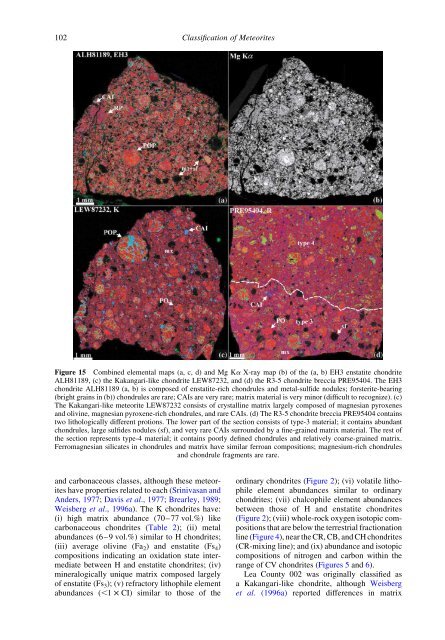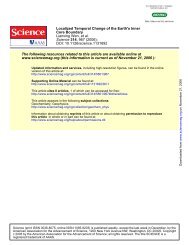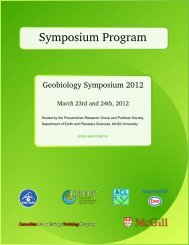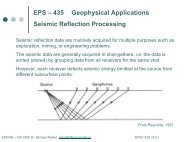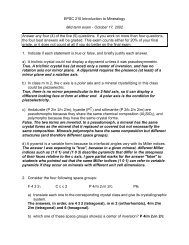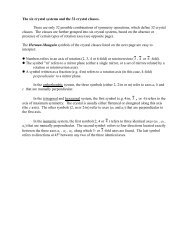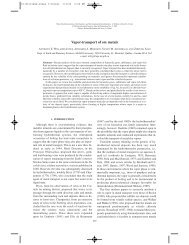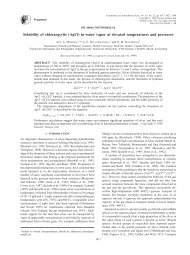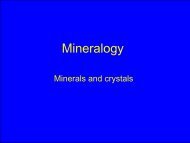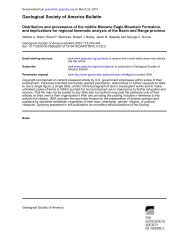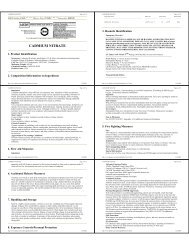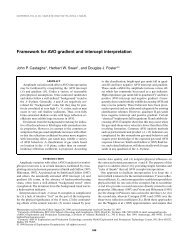05 Classification of.. - Department of Earth and Planetary Sciences
05 Classification of.. - Department of Earth and Planetary Sciences
05 Classification of.. - Department of Earth and Planetary Sciences
Create successful ePaper yourself
Turn your PDF publications into a flip-book with our unique Google optimized e-Paper software.
102<br />
<strong>Classification</strong> <strong>of</strong> Meteorites<br />
Figure 15 Combined elemental maps (a, c, d) <strong>and</strong> Mg Ka X-ray map (b) <strong>of</strong> the (a, b) EH3 enstatite chondrite<br />
ALH81189, (c) the Kakangari-like chondrite LEW87232, <strong>and</strong> (d) the R3-5 chondrite breccia PRE95404. The EH3<br />
chondrite ALH81189 (a, b) is composed <strong>of</strong> enstatite-rich chondrules <strong>and</strong> metal-sulfide nodules; forsterite-bearing<br />
(bright grains in (b)) chondrules are rare; CAIs are very rare; matrix material is very minor (difficult to recognize). (c)<br />
The Kakangari-like meteorite LEW87232 consists <strong>of</strong> crystalline matrix largely composed <strong>of</strong> magnesian pyroxenes<br />
<strong>and</strong> olivine, magnesian pyroxene-rich chondrules, <strong>and</strong> rare CAIs. (d) The R3-5 chondrite breccia PRE95404 contains<br />
two lithologically different protions. The lower part <strong>of</strong> the section consists <strong>of</strong> type-3 material; it contains abundant<br />
chondrules, large sulfides nodules (sf), <strong>and</strong> very rare CAIs surrounded by a fine-grained matrix material. The rest <strong>of</strong><br />
the section represents type-4 material; it contains poorly defined chondrules <strong>and</strong> relatively coarse-grained matrix.<br />
Ferromagnesian silicates in chondrules <strong>and</strong> matrix have similar ferroan compositions; magnesium-rich chondrules<br />
<strong>and</strong> chondrule fragments are rare.<br />
<strong>and</strong> carbonaceous classes, although these meteorites<br />
have properties related to each (Srinivasan <strong>and</strong><br />
Anders, 1977; Davis et al., 1977; Brearley, 1989;<br />
Weisberg et al., 1996a). The K chondrites have:<br />
(i) high matrix abundance (70–77 vol.%) like<br />
carbonaceous chondrites (Table 2); (ii) metal<br />
abundances (6–9 vol.%) similar to H chondrites;<br />
(iii) average olivine (Fa 2 ) <strong>and</strong> enstatite (Fs 4 )<br />
compositions indicating an oxidation state intermediate<br />
between H <strong>and</strong> enstatite chondrites; (iv)<br />
mineralogically unique matrix composed largely<br />
<strong>of</strong> enstatite (Fs 3 ); (v) refractory lithophile element<br />
abundances (,1 £ CI) similar to those <strong>of</strong> the<br />
ordinary chondrites (Figure 2); (vi) volatile lithophile<br />
element abundances similar to ordinary<br />
chondrites; (vii) chalcophile element abundances<br />
between those <strong>of</strong> H <strong>and</strong> enstatite chondrites<br />
(Figure 2); (viii) whole-rock oxygen isotopic compositions<br />
that are below the terrestrial fractionation<br />
line (Figure 4), near the CR, CB, <strong>and</strong> CH chondrites<br />
(CR-mixing line); <strong>and</strong> (ix) abundance <strong>and</strong> isotopic<br />
compositions <strong>of</strong> nitrogen <strong>and</strong> carbon within the<br />
range <strong>of</strong> CV chondrites (Figures 5 <strong>and</strong> 6).<br />
Lea County 002 was originally classified as<br />
a Kakangari-like chondrite, although Weisberg<br />
et al. (1996a) reported differences in matrix


